Sunday, January 11, 2004
Today we’re heading to jana’s hometown (where she grew up) in perlis, where we will stay with the cousin with whom she was closest growing up. originally, i was hoping for a hotel, but this will be fine, now that i understand the family relationship.
The trip to perlis. We took the ferry from Penang Island to the mainland then headed north on the main highway for one or two hours to Alor Setar, the capital of the (Malaysian) state of Kedah. Here the mix of people is noticeably different (than that of Penang Island)–predominantly native Malay, with all the women wearing head scarves. I took special note in what the women were wearing, as this was my first experience in a predominately Muslim state (though Kedah is not one of Malaysia’s most intensely Muslim states/areas, which are mostly along the other (eastern) side of the Malay Peninsula). Some of the women were wearing traditional-looking, full-length flowing dress or wraps. Others wore pants and a 2/3s length flowing top or wrap, coming down over the pants. A group of 3 adolescent girls wore jeans & t-shirts. All wore head scarves. [Some women, maybe 20-percent, were bare-headed, but I assumed (possibly incorrectly?) that these represented a non-Muslim part of the population.]
While waiting in the square, one of the local men (who was with his 3-year old son) stopped, asking if I was waiting for someone (yes) and striking up a conversation, asking where I was from. He seemed to take special interest when I said I was from the United States and Washington, DC, asking what I’d seen of Malaysia and how I’d liked it (quite well). He was very friendly and welcoming . . . it happened he was from the same state (Perlis, a very small state on Kedah’s northern border) to which we were headed. After our hour’s stop in Alor Setar, we continued on for another hour to Kangar, the capitol of Perlis & the town in which Jana grew up.
On the way, Jana pointed out to me along the road the flags & office of PAS, a conservative Muslim opposition party that is locally popular with some of the people. [Note: The political party UMNO (United Malays National Organization), which represents the predominant, native-Malay population, has been the predominant force in Malaysian politics for years. UMNO generally has formed a government in coalition with the main Chinese & Indian political parties. There are, however, a number of opposition parties, including PAS. PAS, which would impose a more conservative, Islamic-based law on the Muslim population, has won some local state elections in a couple of the more heavily Muslim majority states on the eastern peninsular coast in the past. However, in recent elections in March, 2004, it suffered serious reversals.]
cheap beer lyrics Meeting Jana’s Relatives in Perlis:
Jana’s relatives in Perlis include, primarily, her mother’s two brothers (uncles), their wives & their children (cousins). One of Jana’s uncles (Big Uncle) was a politician . . . he owned the shopfront house, where the family business was housed (ground floor, front). Jana, with her mother, brother and sister, lived there (ground floor rear), rent free, after Jana’s father died (when she was 6 years old?). Big Uncle, his wife, and 7 children, all lived on the 2nd floor, above. Jana grew up with these 7 cousins–6 girls and a boy. Jana was also close with Second Uncle’s 4 children, who lived nearby.
Trip to Cameron Highlands–January 17, 2004
I’m on the bus, Penang to Ipoh (& from there, on to Tanah Rata in Cameron Highlands, where I hope to be staying at the Hillview Inn tonight). I am taking this side-trip on my own, while Jana stays in Air Itam with her relatives. My primary objective is to get away from the tropical heat and humidity of the lowlands for a few days of quiet contemplation.
I’d thought I’d been sold a ticket on a bus that went straight through to Tanah Rata, but apparently that is not the case, as I learned from the driver on boarding the bus. He reassures me, however, that the transfer will go very smoothly.
later same day:
The journey from Penang to Ipoh on the main highway became more scenic after an hour or so, when we began climbing from the lowlands, coming into hilly terrain. Some rocky, knobby hills were half cut away, exposing raw stone (and, in one case, what may formerly have been half of a tall cavern). Likely this was the work of man, as there was what appeared to be a cement plant nearby [Malaysia has extensive deposits of limestone, which are the basis of the cement industry]. Mostly, though, the hills were covered with dense, tropical vegetation, trees mainly. Some of the land, where arable, was cultivated–I saw rows & rows of oil palms and rubber trees (and other things I didn’t recognize).
The bus to Ipoh was not the most capable on steep grades . . . in fact, it was one of the slower vehicles on the road, joining the big rigs in the slow lane. Upon arriving in Ipoh I faced a period of uncertainty. After we disembarked, I wanted not to lose track of the driver, who had promised to show me when & where to get the bus that would proceed to Tanah Rata. He told me to wait near the entrance/exit of a (very hot) open air eatery. I wanted to use a toilet, if I could find one, yet didn’t want to leave the designated spot for fear of missing out (then, too, there’d be the question how to manage my big, soft-sided bag if I went to the restroom . . . I could easily manage the two smaller, shoulder-strap bags while using the facility but was uncertain about the large one, as I knew from experience the restroom would probably be wet and dirty (certainly there’d be no place on the floor where I’d want to set a bag).
I decided to wait . . . once I found the bus to Tanah Rata, maybe there’d be time to use a restroom [note: the buses here, even the intercity, air-conditioned buses, generally have no toilet facilities]. If need be, I could use one of my old, empty, water bottles to piss into. As I waited, I imagined being stranded and needing to find a place to stay in Ipoh (not a pleasant thought, especially as I’d already paid for my ‘ticket’ and felt honor-bound to pay for the lodging in Tanah Rata, as I’d given my word I’d not “no show” if they held the room for my late arrival).
After a bit, though, my first-leg bus driver came back and showed me the way to my connecting bus, which I happily boarded, past several children hawking refreshments. Once assured (as well as I could be) that the bus would not be leaving for another 10 minutes, I left my big bag on one of the seats and found a restroom with time to spare.
11:40pm
I’m in Tanah Rata at the Hillview Inn and it looks like everything is going to be cool. Not only is the town of considerable size (3000) but it has at least 2 24-hour restaurants. The elevation here is about 5000 feet, though I’d have guessed higher based on the amount of time the bus spent climbing the narrow, hairpin-curved road to get here. The driver was very good, and the bus was quite capable, as well, having no difficulties with the steep grade. We saw the aftermath of an accident on the way up, with the wrecked car being towed off and a medium-sized truck pointed into the side of the mountain on one side of the road . . . presumably the two vehicles had met head-on on one of the curves–the front of the car was crumpled-in a couple feet.
My room, I see, is not a non-smoking room, though the smoke smell is relatively light. I don’t know if they have non-smoking rooms, but know they are full for tonight, so am content with what I’ve got. It was great to find someone from the inn waiting at the bus station to pick me up when I arrived. We are, I think, maybe half a mile from the more central part of town. It seems this inn/guesthouse may have a lot of common areas. Not only did I see a couple of people sitting/visiting over a table on the patio on the way in to the office, but, on the way up to my second floor room, I saw what appeared to be a good-sized and comfortable lounge. The room is clean and spartan, with just a bed, table and chair. There is a balcony. The bathroom has a shower (with hot water) in the Malaysian style (there is no shower stall . . . the water goes down a drain on the bathroom floor . . . take care to remove the toilet paper from the back of the toilet, which is near the shower, if you want to keep the paper dry).
As a (former?) tropical hill station, Cameron Highlands is, in one sense, unlike any place I’ve ever been before–its climate is what I might call “perpetual Springtime.” I’m used temperatures changing with the seasons or staying warm year-round. In Cameron Highlands, however, the temperature rarely gets above 75 degrees Fahrenheit in the day or below 50 degrees Fahrenheit at night. Being as Spring is my favorite season, this suits me fine. This also a place rich in vegetation, ranging from temperate ‘jungle’, to tea plantations, vegetable farming & flower raising.
South Africa Here are a few pictures taken in Cameron Highlands around Tanah Rata:

Boh Tea Estate, land
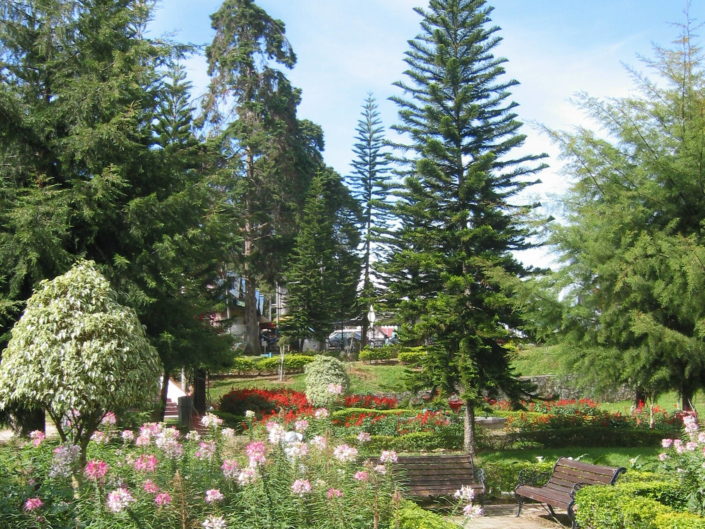
Children’s park
in Tanah Rata
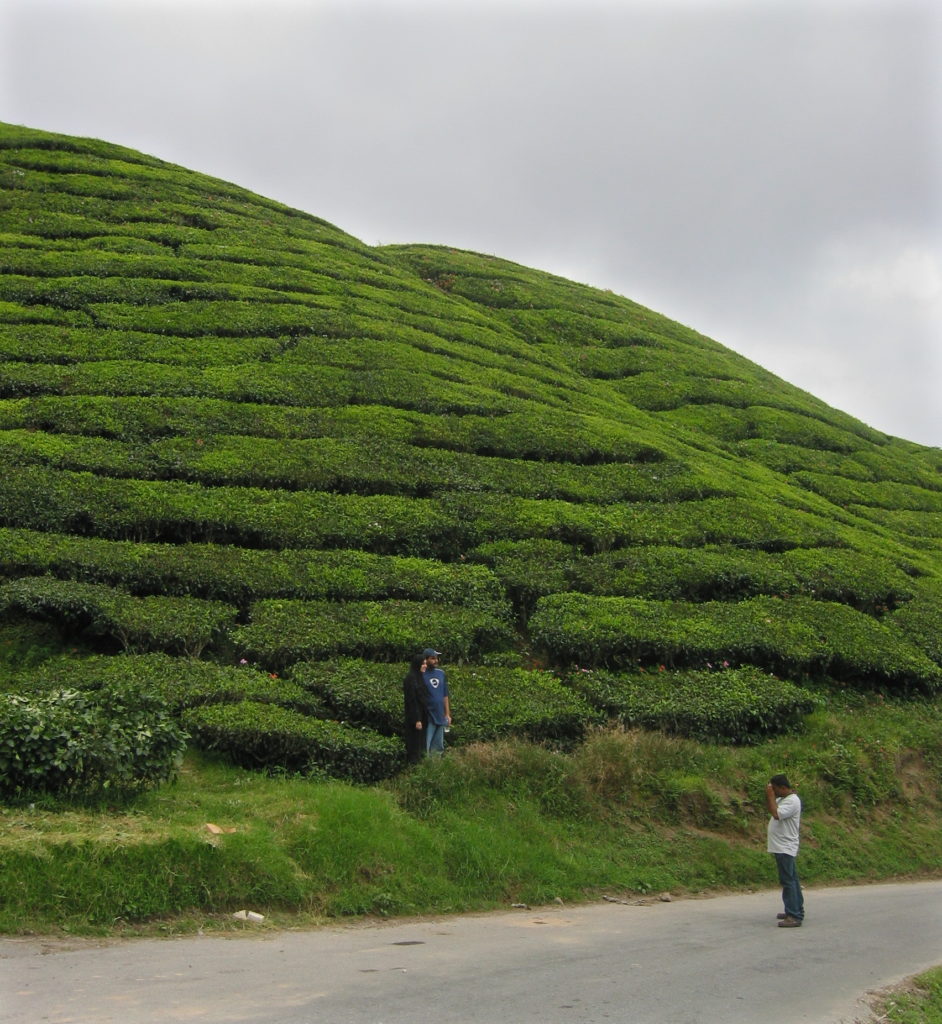
Tea bushes on hillside,
showing pathways worker’s
use to cut new growth
tea leaves

Tea estate –
worker’s lodging
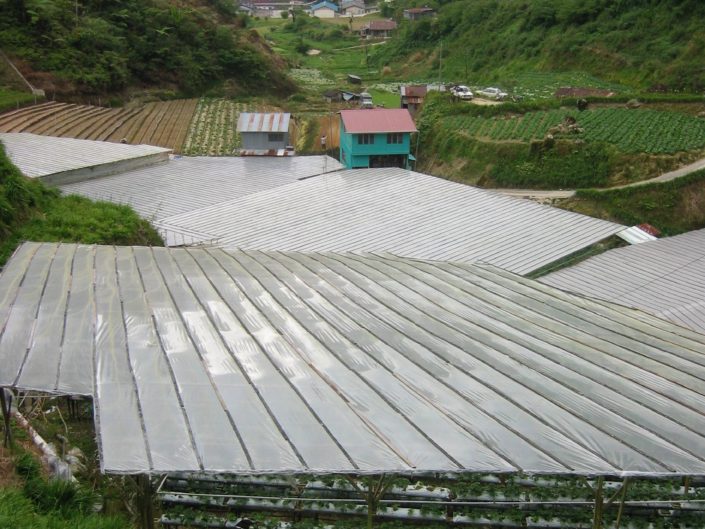
Strawberry farm & view
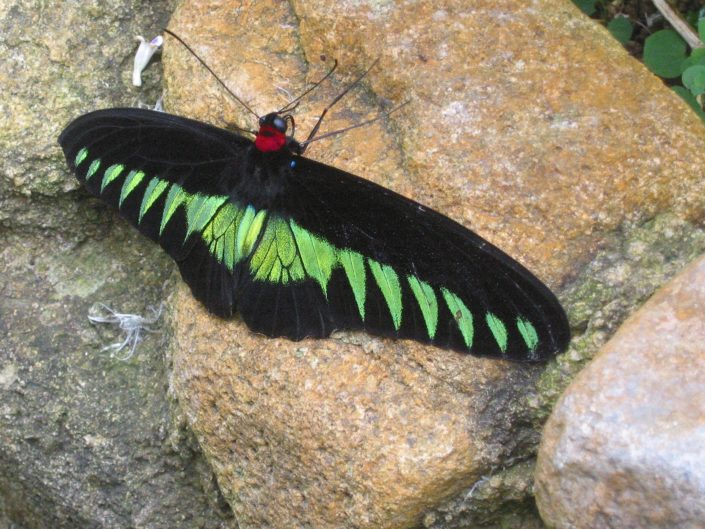
Butterfly on rocks
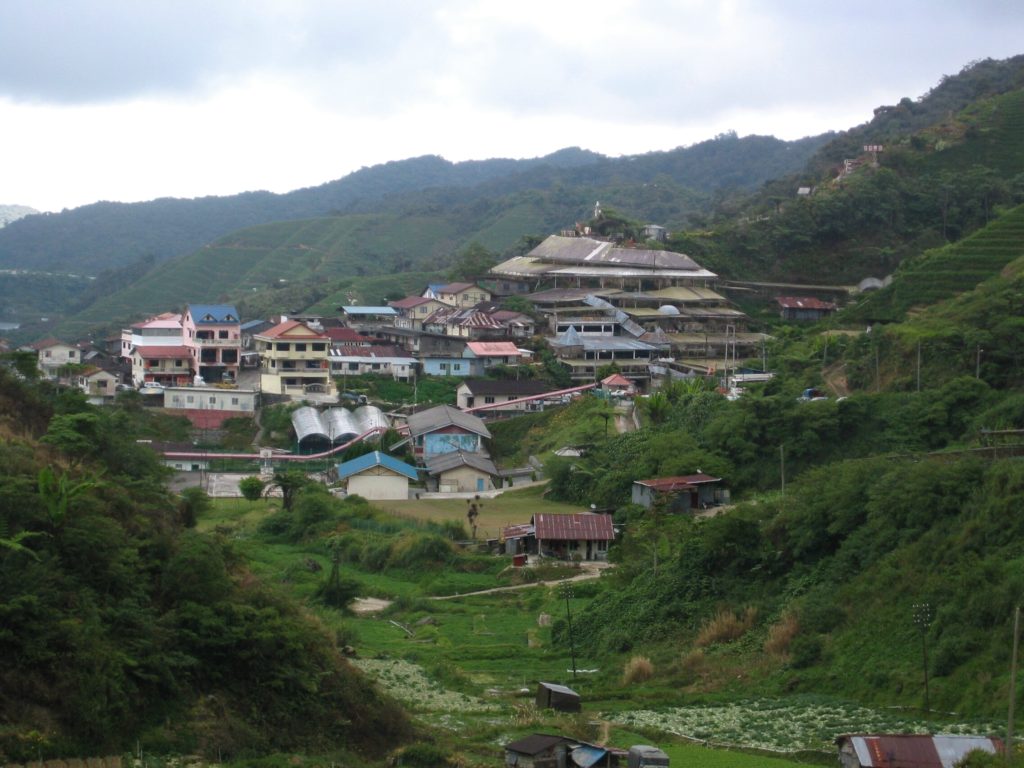
View of a town on hillside
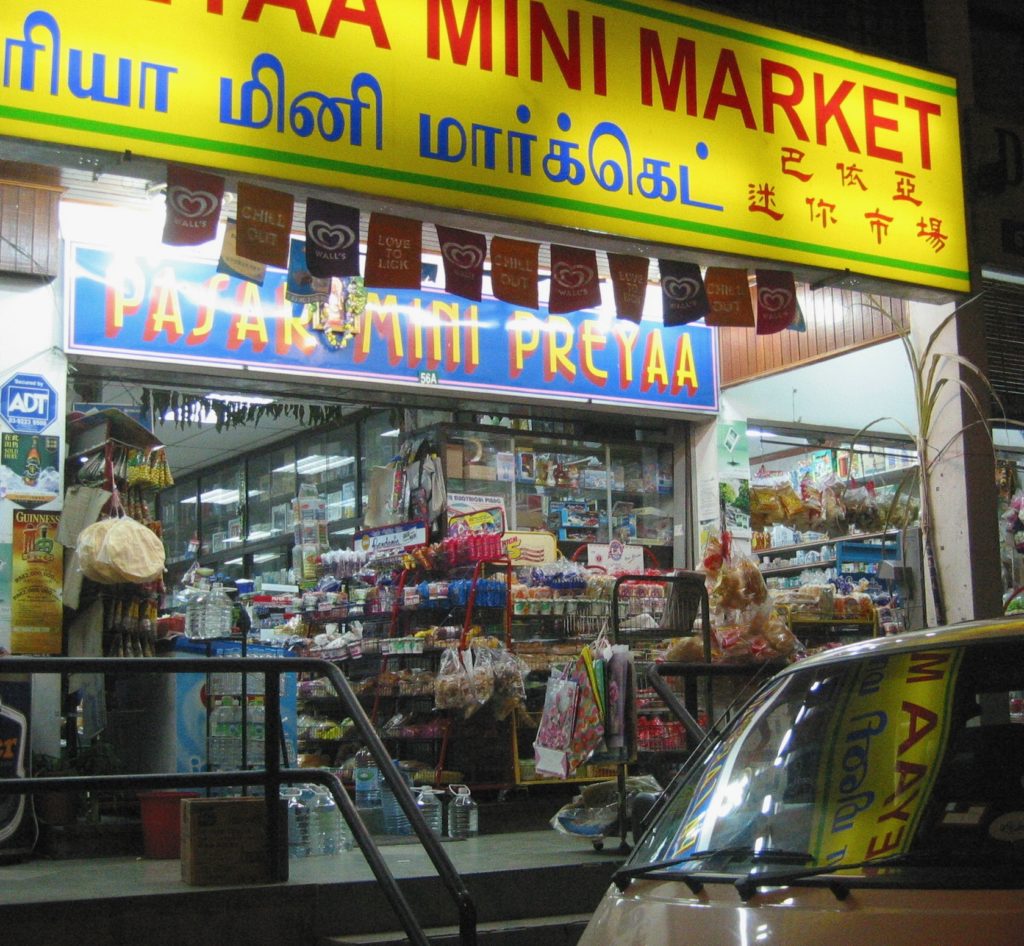
Tanah Rata mini-market,
night
Leaving Cameron Highlands:
I boarded the bus just before 8am, provisioned with a sardine canai and a banana canai (neither with curry) from Suria, the simple restaurant where I’d taken most of my meals during my visit (and, according to Lonely Planet, one of the best sources of southern Indian food in Malaysia). We left on schedule, beginning our slow, winding descent from the Highlands. The morning was partly cloudy, with foggy mists nearly completely shrouding the more distant ranges of hills. On the left of the bus, the steep hillside rose above us, thickly covered in the vegetation of what I assumed was a temperate rainforest. A cooling breeze intermittently wafted through bus as it rolled from side to side on the hairpin curves, its window curtains sliding back and forth on their rods, reminding me of the rhythm one sometimes feels ‘riding the rails’.
On the other side of the aisle, just slightly forward, sat a young father playing with his beautiful baby daughter, holding her up to ‘stand’ in his lap as the bus rocked its way down the hill. I couldn’t (didn’t) resist the urge to take a few pictures. The young father saw this, pleased, I think, that I was capturing the attention of his daughter. I showed him, and his young wife, one of the cute pictures I had taken (to their evident delight), whereupon the young father surprised me, holding the baby out to me. I wasn’t sure whether he was inviting me to hold her or merely to touch, but I soon found myself lifting her over to my side of the bus and holding her on my lap, one arm under her head, and the other hand free to support her back and give her a steady gently-squeezing caress on her side, tenderly, rhythmically . . . occasionally touching her little hands, seeing if she’d grip my finger (she didn’t). Within a minute or two she was asleep in my lap. The parents were apparently comfortable with this state of affairs, in that they, too, were soon dozing, leaving the baby in my care!
I was rather flattered that they so trusted me, a stranger, with their most valuable possession. Mind you, in my sheltered life, I’ve had virtually no experience holding a baby, at least not for more than a few seconds, though I’ve held women and dogs and must admit I seem a natural. Holding this baby was rather an unaccustomed treat for me. As I held her, lovingly and soothingly, I found myself feeling more peaceful and content.
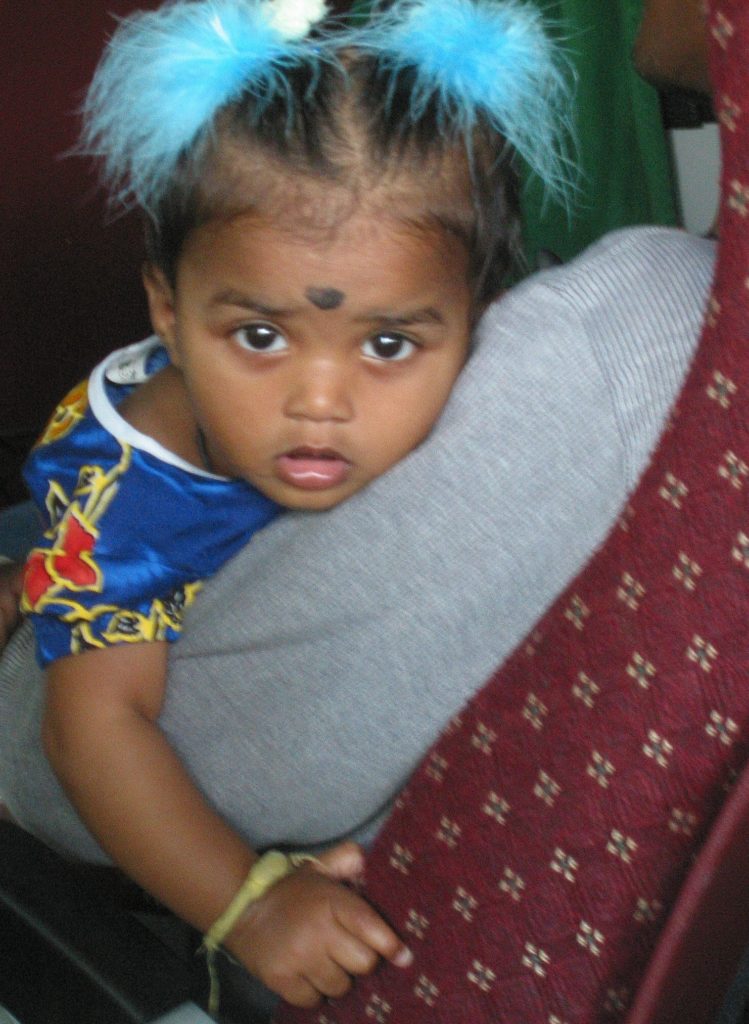
The baby on the bus
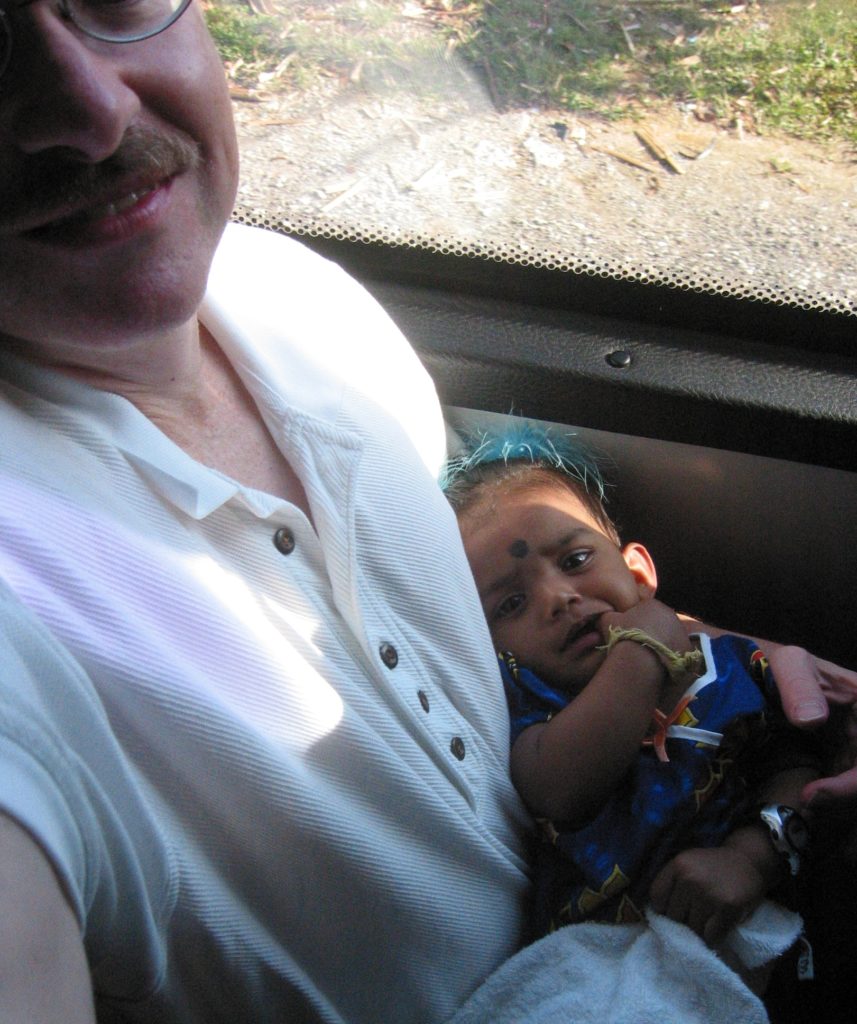
Sleeping in my arms
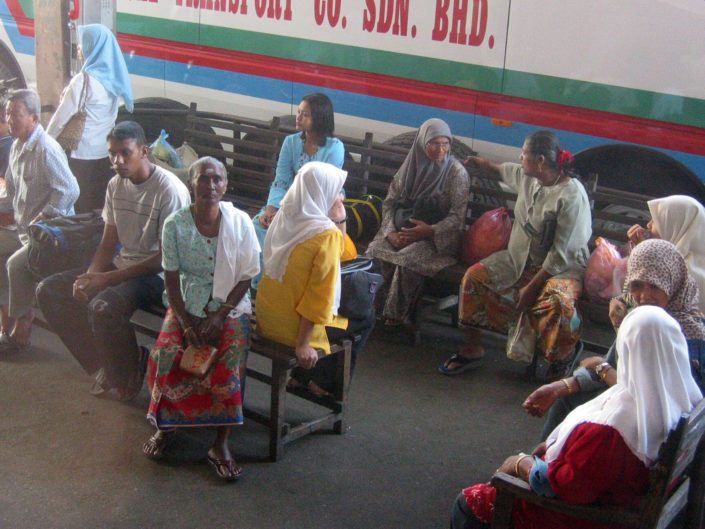
People waiting, at the bus station
Hatyai, Thailand.
Hatyai was an interesting diversion, actually one of the more memorable parts of my trip. First, I got to see part of another country & compare how things were there with what I’d seen in Malaysia. The difference was bit so great . . . after all, Hatyai is only about 50 miles from the Malaysian border. I did catch sight, though, of a few old Thai style (presumably Buddhist) temples, though the southern part of Thailand (especially further east (from Hatyai)) is, I understand, where most of Thailand’s Muslims reside. In fact, there was some trouble in that part of Thailand just a few weeks ago, when a “separatist” group (some say “terrorist”) set fire to some 17 schools (as a diversion?) and raided some sort of police station, killing 3?, and taking about 100 weapons.
Nonetheless, it was business as usual in Hatyai, except that the number of Malaysian tourists was down from what one would normally expect. Governmental response to the threat was swift, as Thailand & Malaysia agreed to joint military patrols along the western part of their shared border to deter such activity.
We stayed at the Lee Gardens Plaza Hotel in the heart of the central shopping district. In fact, the first 4 or 5 floors of the building housing the hotel contained a smallish, upscale shopping mall frequented by affluent Thai youth, a few westerners and other tourists. There was a multiplex showing the latest western movies in Thai, as well as shops selling well-known clothing brands, and others featuring locally-made clothing. Also, there was a small internet café, and a variety of eateries, ranging from fast-food & food court fare to an excellent Japanese restaurant. Coffees and other snacks were available, along with a few nicely placed tables and chairs for comfortably hanging out. In short, it was not a bad place if one happened to be a homesick Westerner.
The hotel lobby was on the 10th floor and our room on the 31st. Our double seemed to be a pretty good value at 1100 baht per night (about $30US). In fact, the dollar goes even further in Thailand, than in Malaysia, which explains why some Malaysians regularly make shopping excursions across the border. On the twelfth floor there is a rooftop swimming pool and a garden with a circular path which could be used to walk or jog, if one wished. I might have so wished were in not for the fact the air was rather badly polluted & smelly, smoggy. Whatever you want to call it, it was worse than anything I’d seen in Malaysia, though there were some similarities–at street level, I was often aware of the smell of sewage emanating from the trench sewer system . . . sewage flows along the edge of the streets in concrete lined trenches about 2 feet deep, which are generally covered by grates or concrete slabs for peoples’ protection (though it’s not unusual for a grate to be missing, so one must watch one’s step along the curb).
Our hotel room was sparsely furnished with the basics (bed, table, chair, drawers, etc.), but the bathroom was large and finely appointed. Generally, the room’s A/C and lighting could not be left on while one was out, in that they were activated only when the room’s key card was inserted in the slot near the room’s entrance. I did not sleep well my first night, as my bed was the one further from the effect of the air-conditioner. Also, I could readily smell the smog, even in the room. The second night was better, however, when I switched beds with Jana.
There were quite a few shopping possibilities in the few blocks right around the hotel, ranging from the Western-style department store, just across the street, to the stalls lining the sidewalks, selling hot meals, pre-packed foods, clothing, etc. There were a couple indoor shopping malls, less upscale than the one at the hotel. In fact, one was little more than a collection of indoor merchant’s stalls.
I also found a retail shopping venue unlike anything I’d seen before–In one building, covering most of an entire city block and maybe 4 or 5 stories high, there were a series of very narrow shopping ‘arcades’ that ran the entire width of the building from an entrance on one street to an exit on another street on the other side of the block. In each arcade, the path for shoppers to walk was very narrow . . . maybe only wide enough for two people to walk abreast, with ceilings sometimes low enough to easily touch. On either side of the narrow walkway, chock-a-block, were merchant’s stalls, each maybe 15 feet long and 5 feet deep–each with enough space, perhaps, for a recessed area in which goods might be displayed or for a counter of merchandise behind which a merchant could stand. One arcade might specialize in selling electronics, another in clothing, etc. Each might have 3 levels, one directly above another, accessible by stairs at either end. There were maybe a total of 5 such multi-level arcades, running, in parallel (and not internally connected) through the building’s width.
On our first night, Jana & I ate in the Japanese restaurant below our hotel. It was my first experience with a full course of sushi and sashimi. I very much enjoyed it, as well as the atmosphere and service. Our entire dinner ran no more than $15 US.
A few pictures from Hatyai, Thailand:
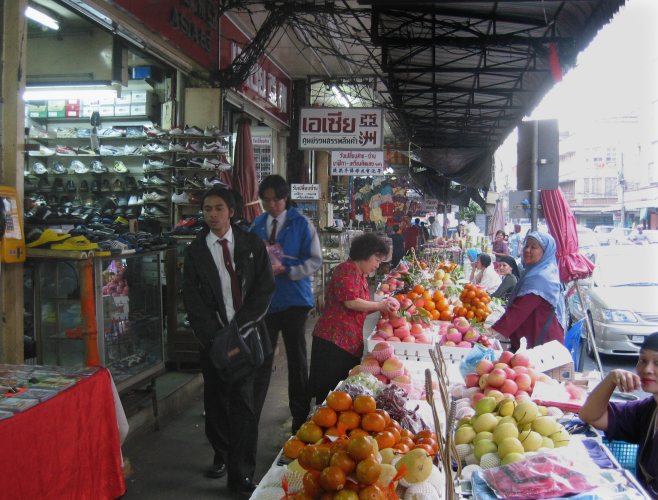
Street market

View down the length of an ‘arcade’

Arcade

Typical buildings on Hatyai street
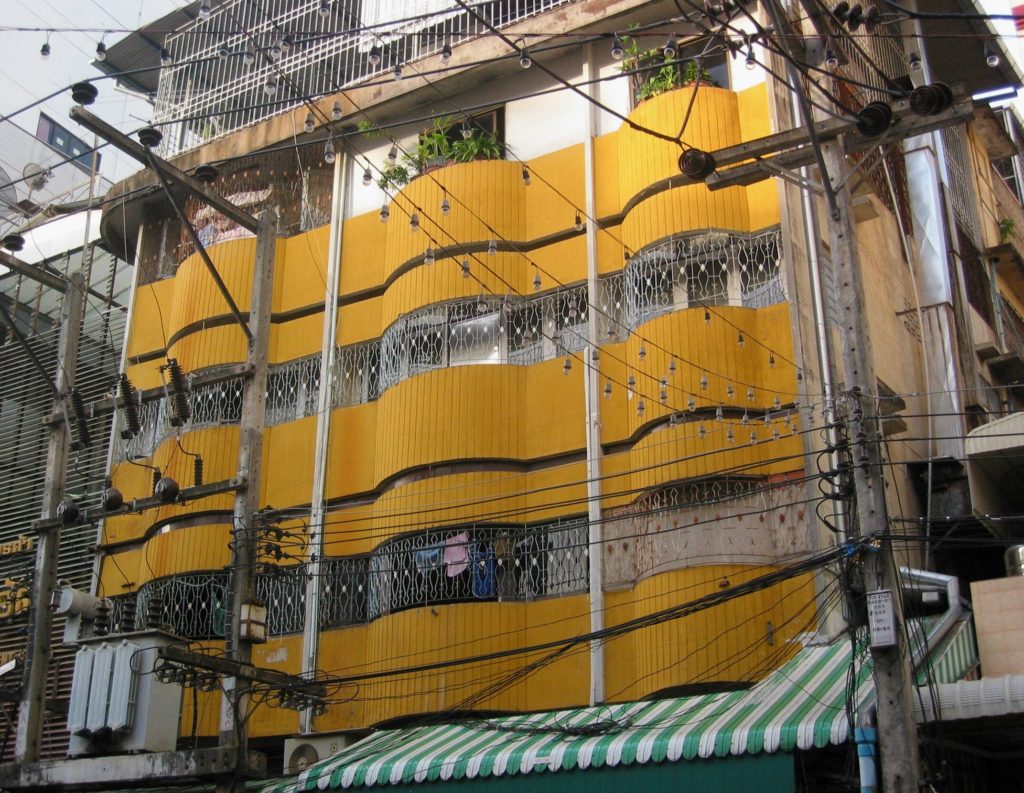
Residential building
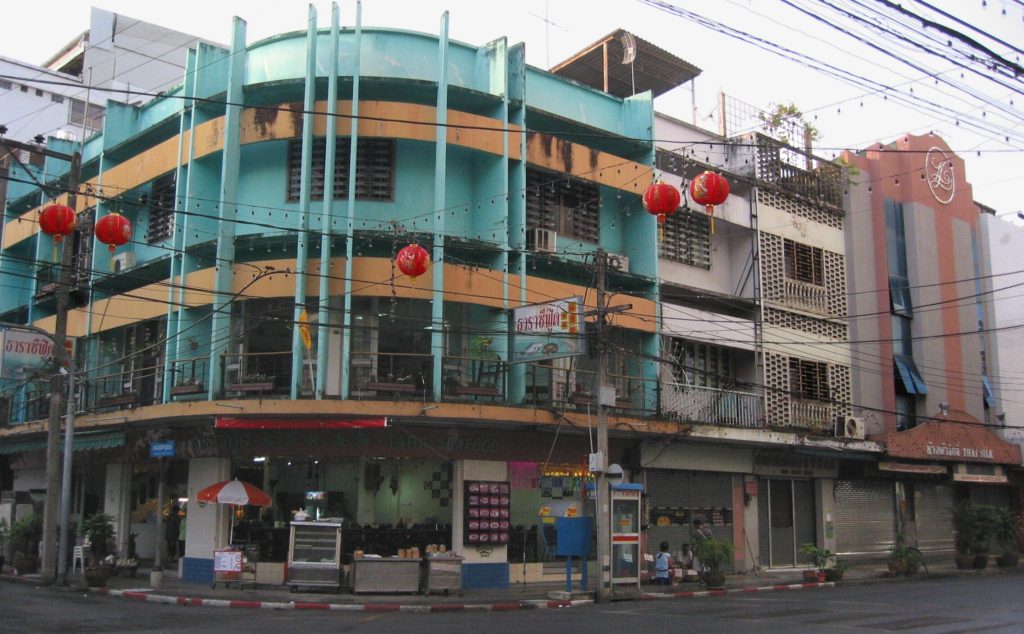
A corner building

Lee Plaza Gardens Hotel
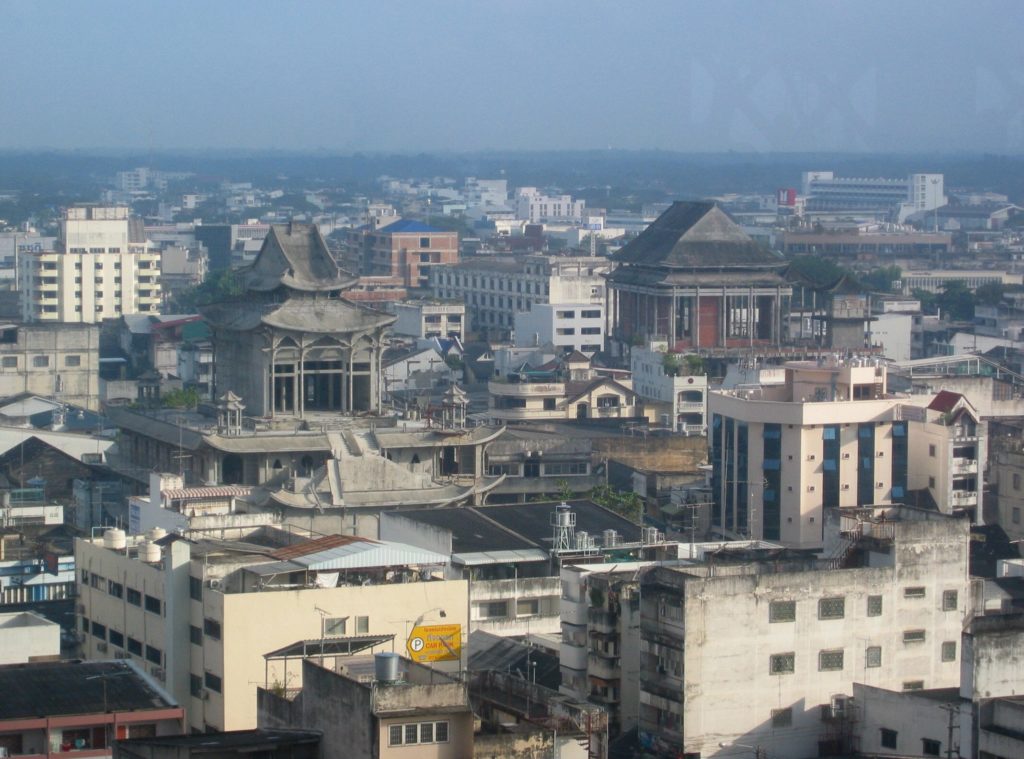
View from dining room,
Lee Plaza Gardens Hotel
Another new experience for me (and an even greater value) was Thai massage. On the 7th floor of our hotel’s building was a large massage center, featuring traditional Thai massage. It appeared to be clean & wholesome, with multiple, freshly sheeted mattresses in the two rooms we were shown by an attendant when we made an inquiry.
Nonetheless, even making this inquiry was a bit of an experience, in that, when we entered the facility, we saw, on our left, a room full of young women (maybe 20), sitting in a multi-tiered space, behind glass. They became alert the moment we entered, some smiling or preening, hoping to be chosen to provide a massage. We made no selection that night, but learned that a 1.5 hour massage would run 240 baht (about $7 US). Jana had a massage the next day, and I, the following.
Entering the facility for my massage, first off, I needed to choose a girl for the job. Many of the girls do not speak English. Jana had learned from her masseuse the previous day that one might get a better quality massage by asking for one of the ‘teachers’ (apparently, a few of the more senior, experienced women, teach the girls the trade). In making a selection, I would like to have found an English-speaking teacher of pleasing appearance. However, it didn’t work out that way.
I was a bit anxious about the whole thing. Upon entering the facility, I was approached by a woman from behind a counter who mediated my making of a selection. Unfortunately and unexpectedly, she, herself, wasn’t very good with English. Though I thought I’d communicated my preference for an (English-speaking?) teacher, I instead was given a girl who was neither a teacher, nor spoke any English. I was shown to a room with a single, freshly made-up mattress on the floor and asked to change into a robe (which I did, though I left my socks on, as the floor was cold).
My masseuse entered with a pot of hot tea (I poured myself a cup) and turned on the TV. First there was some soothing music, but soon the channel had been changed to some sort of a soap-opera (though, thankfully, the sound was low). I tried to request more soothing music, but to no avail because of the language barrier. I was concerned she might become absorbed in the soap-opera, such that her attention to my massage would become desultory. I was on the verge of disaffection, thinking, “what can you expect for $7,” when saw that her attention to my massage was in no way lacking. In fact, I came to see her as a sincere young woman who wanted to do a good job providing her service.
Her massage pretty much covered my whole body, beginning with the extremities. While I would have liked a more vigorous, deeper massage in many areas, she did one thing that I still find pretty amazing–she somehow managed to flex/crack back my vertebrae by bending me backwards over her hunched back, lifting me entirely off the ground and jerking, causing my back to crack in what I felt was quite a satisfactory way. I guess it’s all a matter of the proper mechanics, but this she did very well!
In the end, I was quite pleased and, though I didn’t know whether tipping was expected or even permitted, I determined to give her a good tip. After donning my street clothes, I went forward to the front desk, where I was rejoined by my masseuse as the attendant took my $240 baht payment. I unobtrusively handed 3 20 baht notes to my masseuse (I never did learn her name), who, looking discreetly between her hands to see what she had received, immediately gave me a quick bow of happy appreciation, with her hands together, palm to palm, in a way I associate with Buddhist practice. I felt good, seeing her so pleased . . . a pleasant note on which to end our visit to Hatyai.
Return to Beginning of Malaysia Journal.
I welcome any questions or comments.
To contact me (Keith Stanley), please email me at kesta1001@yahoo.com.
Here are some links to others of my pages: